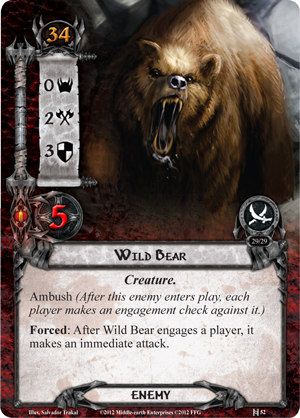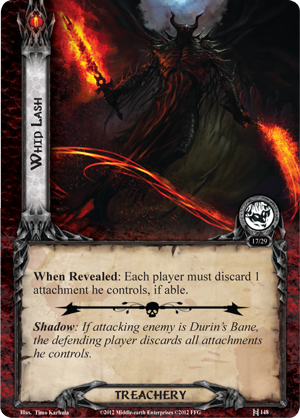From the original FFG article here:

“The road must be trod, but it will be very hard. And neither strength nor wisdom will carry us far upon it. This quest may be attempted by the weak with as much hope as the strong. Yet such is oft the course of deeds that move the wheels of the world: small hands do them because they must, while the eyes of the great are elsewhere.” –Elrond, The Fellowship of the Ring
–Elrond, The Fellowship of the Ring
 –Elrond, The Fellowship of the Ring
–Elrond, The Fellowship of the RingThrough The Redhorn Gate and along the Road to Rivendell, Arwen and the heroes of Middle-earth have been taxed nearly to their limits by snowstorms, perilous mountain passes, and wave after wave of ferocious ambushes. Now, at long last they have arrived safely at the Last Homely House. Though some of the heroes may hope their journeys through the Dwarrowdelf have come to an end, the truth is that they’ve only just begun.
Elrond, the master of Rivendell, is troubled by the great numbers of Orcs that once again infest the Misty Mountains. Many years have passed since the Orcs posed such a threat, and their return is troubling. Accordingly, Elrond asks the heroes of Middle-earth to explore the mines of Moria for the source of the increased Orc activity. But before the heroes can explore Moria’s vast network of tunnels, they must first gain entrance…
Beneath the gaze of the great
As we look forward to the release of The Watcher in the Water, the third Adventure Pack in the Dwarrowdelf cycle for The Lord of the Rings: The Card Game, we’ll take a close, practical, three-part look at the game’s new Secrecy mechanic, concluding with a deck list featuring the pack’s new hero.
While we’ve already learned how the mechanic works in an article on deck-building and received design insights in apreview of The Redhorn Gate, these haven’t been “practical” explorations of the mechanic. Why? The game hadn’t yet reached the critical mass of Secrecy cards and effects to make a Secrecy deck viable. The Secrecy cards introduced with the first two Dwarrowdelf Adventure Packs may present some excellent, cost-effective benefits for players who can keep their threat at 20 or below, but they don’t, on their own, offer enough reward to encourage decks built specifically to take advantage of Secrecy discounts.
That may change with The Watcher in the Water. This Adventure Pack introduces only one new card with the Secrecy keyword, but it bolsters the strategy with a number of exciting new cards that provide the card draw, resource acceleration, and threat manipulation that Secrecy decks need.
The aid of the Last Homely House
The master of Rivendell and his daughter lend their aid in The Watcher in the Water. Elrond lends your heroes his counsel before they set forth into the wild, and Arwen Undómiel (The Watcher in the Water, 58), having just traveled with the heroes across the Misty Mountains, offers to travel with them once more as an ally.
Though Elrond’s Counsel (The Watcher in the Water, 59) may soon form a core component of most Secrecy decks, it can easily fit into any deck with a Spirit hero. For the cost only of the card draw, Elrond’s Counsel both boosts a character’s Willpower by one and reduces your threat by three. Threat reduction is always good, and additional Willpower is always welcome, too.
Elrond’s Counsel put to the test
So what’s the catch? First of all, you need to control a unique Noldor character. While the new Arwen ally happens to be a Noldor from the Spirit sphere, she’s the only one. The only Noldor characters currently in the game include her brothers Elrohir (The Redhorn Gate, 1) and Elladan (Road to Rivendell, 28). They belong, respectively, to the Leadership and Tactics spheres. Then, there are only two more unique Noldor characters, Glorfindel (Core Set, 11) and Gildor Inglorion (The Hills of Emyn Muil, 79). This means the most reliable way to receive the benefits of Elrond’s Counsel is to start the game with a Noldor hero paired alongside a Spirit hero. Since the majority of the game’s Secrecy cards currently belong to the Leadership and Lore spheres, a two-hero Secrecy deck might be able to make good use of either Elrohir or Glorfindel.
 Pairing Elrohir with a character like Éowyn (Core Set, 7) means you start both with considerable Willpower to apply toward the quest, as well as the ability to ready a defender to attack. Elrohir’s Leadership icon allows you to make use of the fantastic event, Timely Aid (The Redhorn Gate, 3), and though it’s true Elrohir doesn’t have the greatest Defense Strength without Elladan in play, it’s still possible to bolster his defense with Dúnedain Warning (Conflict at the Carrock, 26) and Arwen’s ability.
Pairing Elrohir with a character like Éowyn (Core Set, 7) means you start both with considerable Willpower to apply toward the quest, as well as the ability to ready a defender to attack. Elrohir’s Leadership icon allows you to make use of the fantastic event, Timely Aid (The Redhorn Gate, 3), and though it’s true Elrohir doesn’t have the greatest Defense Strength without Elladan in play, it’s still possible to bolster his defense with Dúnedain Warning (Conflict at the Carrock, 26) and Arwen’s ability.Alternatively, you could pair Glorfindel with Frodo Baggins (Conflict at the Carrock, 25) or Dúnhere (Core Set, 9), either one of whom grants extra action potential, either by soaking wounds as threat and releasing you from the need of assigning a defender in certain situations, or by attacking enemies in the staging area, releasing you from the need to defend them. Meanwhile, the Lore sphere benefits from such Secrecy cards as Needful to Know (The Redhorn Gate, 9) and Out of the Wild (Road to Rivendell, 36).
If you build the right support into your deck, any of these starting fellowships provides you the means to push forward on your quest – all while remaining beneath the notice of most enemies. Your enemies might build up in the staging area, and you’ll need to confront them eventually, but if you adopt a good measure of Secrecy and heed Elrond’s Counsel, you should be able to recruit enough allies to your cause to deal with the enemies when the time is right.
Thus ends the first part of our look at how Secrecy hits critical mass in The Watcher in the Water. Check back over the next couple weeks for more previews and a Secrecy-focused deck list!







 Suddenly Aragorn leapt to his feet. “How the wind howls!” he cried. “It is howling with wolf-voices. The Wargs have come west of the Mountains!”
Suddenly Aragorn leapt to his feet. “How the wind howls!” he cried. “It is howling with wolf-voices. The Wargs have come west of the Mountains!”





